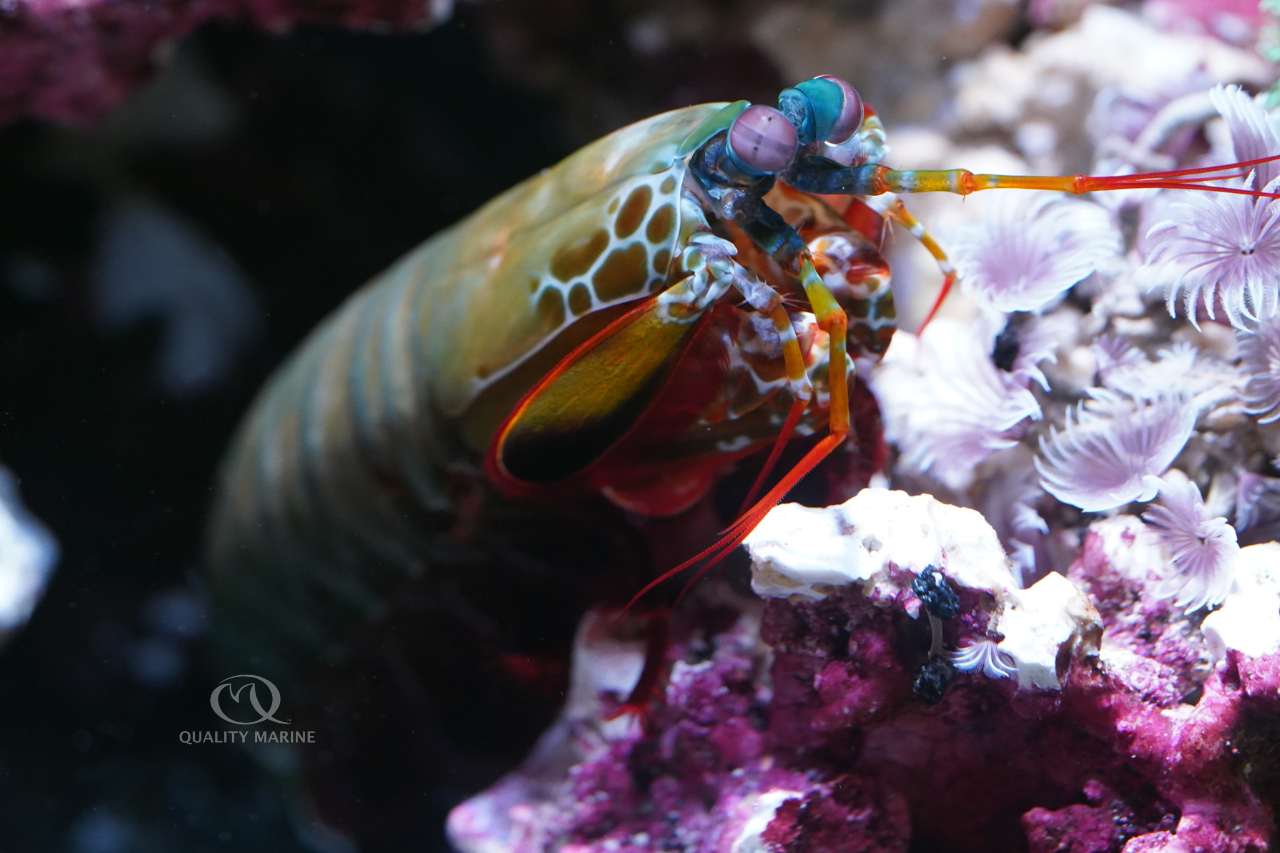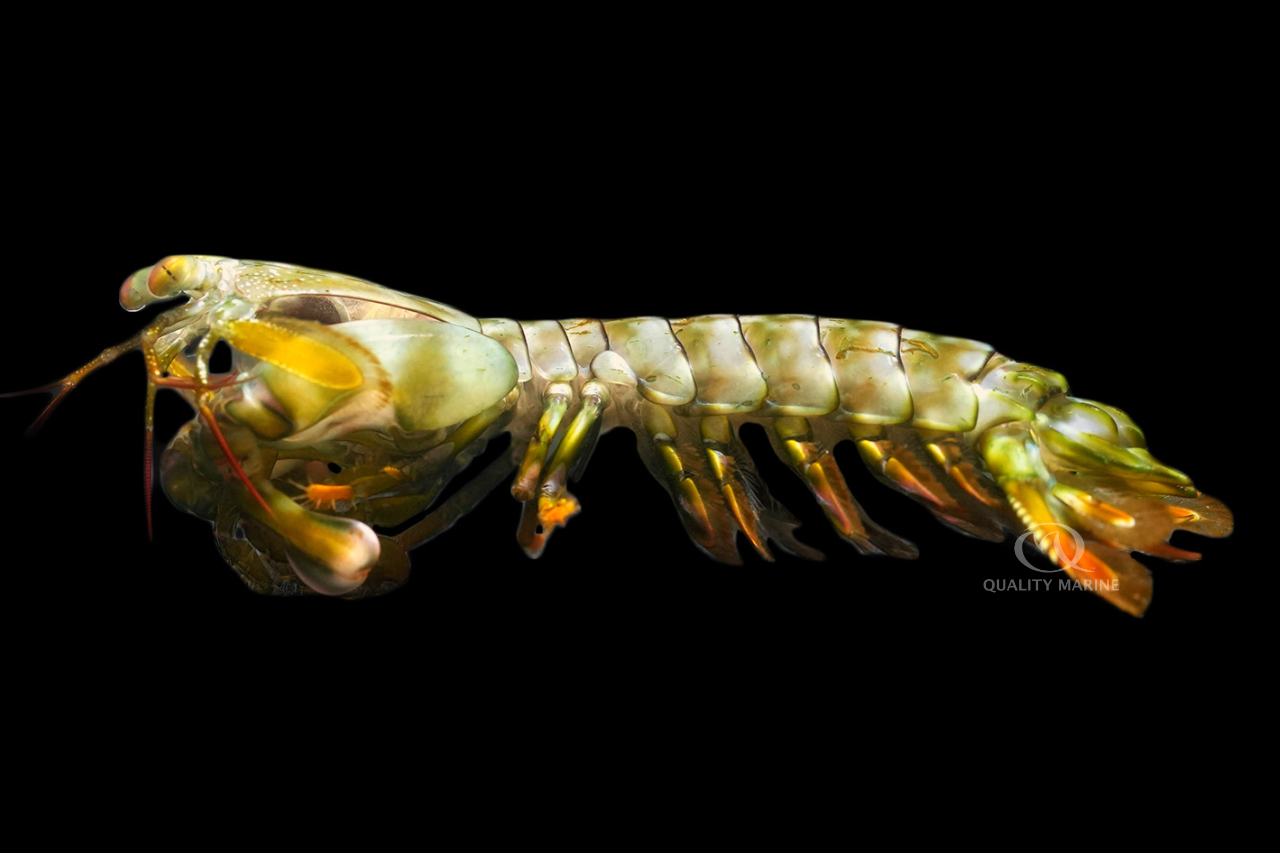Smashing Stomatopods (Mantis Care II)

If you read our previous article on mantis shrimp, and your interest was piqued we’re going to continue that discussion today! So now that we have learned about mantis shrimps and some of their amazing adaptations that make them maybe the most intriguing option a wet pet we can get, we can get into the meat and potatoes – how does one set up an aquarium for a mantis shrimp and what species might make the most sense for you!
As we go over some of the more common species of mantis shrimp being offered for sale its important to note that identifying mantis shrimp is not always easy and is sometimes almost impossible to do on a small, living specimen. Color alone should not be used as a distinguishing characteristic because color of mantis species is not only variable from individual to individual but can also be different from molt to molt with the same individual. Usually, color will reflect the habitat the mantis finds itself in. Seagrass? Green. An open sand flat? Off white. Deeper, darker waters? Red or black. And there are many other colors between. With a young mantis it might be possible to change the substrate and watch them change colors the next time they molt!
With some basic research you can find good guides online to precisely guiding you through stomatopod identification, but the odds of you being able to do this with a photo of a mantis being sold online, or even one available in a pet store is slim. Two commonly offered species which we will discuss below are the Green Mantis Shrimp (Gonodactylellus viridis) a small, variably colored mantis from the Pacific and Indian oceans and the Caribbean Rock Mantis (Neogonodactylus wennerae) which while “generally” green or brown they come in a wide variety of colors again dependent on where they were collected and the conditions under which they are held. Both of these species' names are often used as catch all categories for when small stomatopods (mantis shrimp) need to be labeled for sale.

The Peacock Mantis (Odontodactylus scyllarus) is probably the most iconic of all the species. Its commonly offered for sale, reasonably easy to identify, and is stunningly beautiful. Hailing from the Indian and Pacific Oceans this seven-inch-long mantis lives in water ranging in depth from about thirty feet to well over a hundred and prefers bottom with some rock rubble or shell debris. It uses these larger pieces to help support the u-shaped burrow that it will dig in the sand. Commonly available, and beautiful if you have a larger tank, it should be considered. They do get large enough to break glass and are known as a “smasher” meaning that in the wild they break into clams, mussels, snails, crabs and anything else shelled to feed on the tasty bits inside. Make sure that their accommodations are safe to keep them in (for both the animal and the tank). So, you'll want to make sure they aren't going to start trying to hit the glass of your tank.
The Green Mantis Shrimp (Gonodactylellus viridis) only reach a little over two inches and can come in a wide variety of colors despite their name. They make a good choice for an aquarium resident, and are one of the more commonly offered mantis from the Pacific Ocean where they seek shelter in shallow waters; making their homes in basically any small space they can find: shells, rock rubble, cracks in the reef etc. Green Mantis are also smashers, but they stay smaller than Peacock Mantis.
The Caribbean Rock Mantis (Neogonodactylus wennerae) is another variably colored mantis that gets only a little over three inches long. Mostly found intertidally in sand flats, shallow reef and mangroves they can also be found to a depth of almost 100 feet! No doubt this plays a role in the diversity of colors that they can be. Interestingly, Caribbean Rock Mantis kept under bright aquarium lights will frequently turn green after a few molts. They are likely the most commonly sold mantis, because they are found in the Caribbean where other inverts for the hobby are often collected. They occasionally pop up as a hitchhiker in farmed live rock. These are also smashers.
While different species of mantis shrimp will require different aquariums but a few important considerations for mantis shrimp habitats are universal across the different species.
After selecting an aquarium that is of suitable size for the species of your choice, one needs to consider the force that a mantis shrimp wields. In glass aquariums, and even some plastic ones it can be enough force to permanently damage the aquarium. So, what can be done? Finding or building an aquarium out of a thicker acrylic can help – or in the case of glass aquariums – laying down a sheet of aquarium safe plastic so that if they smash or spear at the bottom of the tank it won't shatter and drain the whole display onto your floor. Some smashers might even try this to “carve” their way through the bottom of the aquarium to customize their home.
Generally, with some exceptions – mantis shrimp need a sand substrate with some rubble and other pieces to help them give structure to the homes that they will build. This is definitely true of the Peacock Mantis Shrimp (Odontodactylus scyllarus). Coral rubble or live rock rubble and some shells can be had for a reasonable price at almost every saltwater LFS.

Mantis shrimp love to feel protected, and they achieve this by building or finding homes that allow them to hide themselves without much effort. Spearers generally dig their own homes in sandy or silty substrates, and smashers generally hide out in rocks and can sometimes even carve out their own homes within rocks. Offer smaller smashers rocks with appropriately sized holes or build them small caves. Smashers can often be heard smashing away – so make sure to secure rocks as safely as possible to prevent them from causing a cave in on themselves. While this is a risk they take in the wild – and there is very little we can do to stand up to the forces they exert, one would be sad if they injured themselves or (and probably more likely) damaged the aquarium as a result of breaking or moving rocks. Spearers can have deep burrows and so a deep sand bed may be necessary to accommodate larger species.
If you’re still intrigued by stomatopods, we encourage you to jump into the wormhole that is their biology and read as much as possible. While usually hard, it may not be impossible for you to identify them correctly in a local fish store – and if they don’t have any in stock as them to order some sustainably sourced Mantis Shrimp from Quality Marine today!